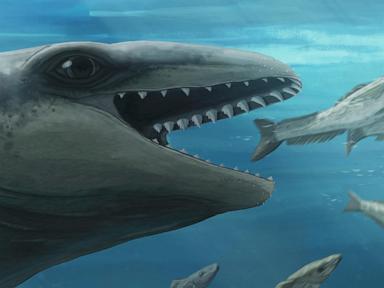Newly Discovered Prehistoric Whale Reveals Evolutionary Secrets

Paleontologists have identified a new species of prehistoric whale following the discovery of a fossil on an Australian beach. The creature, named Janjucetus dullardi, lived approximately 25 million years ago and offers unique insights into whale evolution. The official naming was published in the Zoological Journal of the Linnean Society this week.
Found at Jan Juc Beach in Victoria, Australia, the fossil includes a partial skull, ear bones, and teeth. Researchers describe Janjucetus as a small, yet formidable predator, measuring about 3 meters (10 feet) in length, with teeth resembling those of modern-day sharks and bulging eyes. Its appearance has been compared to a whimsical combination of a whale, a seal, and a character from a popular animated series.
Erich Fitzgerald, senior curator of vertebrate paleontology at Museums Victoria Research Institute, expressed excitement over the discovery. “It was, let’s say, deceptively cute,” Fitzgerald remarked, highlighting the creature’s unique features. He emphasized that Janjucetus dullardi is only the fourth species identified within the mammalodontid group, which thrived during the Oligocene Epoch and represents a pivotal moment in whale evolution.
The discovery took place in 2019 when amateur fossil hunter Ross Dullard stumbled upon the specimen while searching the beach at low tide. Dullard noticed a black object protruding from a cliff, and after dislodging it, he found a tooth that did not belong to any known marine animal. “I thought, geez, we’ve got something special here,” he recalled. His subsequent photographs sent to Museums Victoria led to the confirmation of the new species.
The identification of Janjucetus dullardi marks the first mammalodontid discovered in Australia since 2006, making it a significant find in the field of paleontology. Fitzgerald noted the rarity of such fossils, stating, “Cetaceans represent a fairly minuscule population of all life.” The erosion and scavenging that occur over millions of years often prevent whale skeletons from being preserved.
Discoveries like this one provide critical insights into how early whales adapted to their environments and evolved into the forms seen today. Researchers are studying these ancient cetaceans to understand their feeding habits and behaviors, as well as how they might have responded to the warmer oceans of their time. This research could also shed light on the adaptation of modern marine life in the face of climate change.
Dullard’s excitement over the discovery was palpable, as he planned to celebrate with a fossil-themed party featuring games and treats shaped like whales. “It’s literally been the greatest 24 hours of my life,” he said, reflecting on the joy of sharing his find with friends and family after six years of dedication to his fossil-hunting passion.
As Janjucetus dullardi continues to capture the imaginations of scientists and enthusiasts alike, it stands as a testament to the ongoing journey of understanding prehistoric life and the evolutionary lineage of today’s whales.






